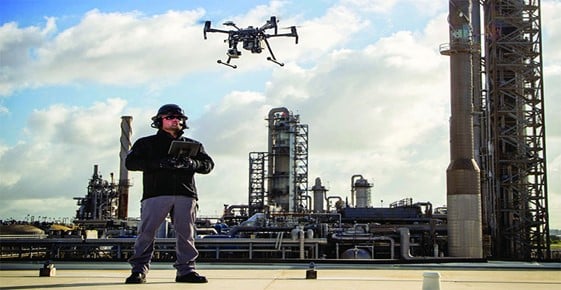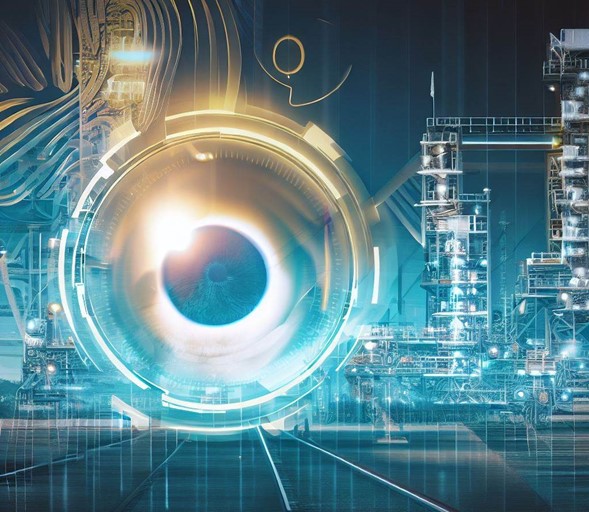Introduction
In the oil industry, asset/equipment inspection is essential to ensure efficiency, safety, and proper maintenance. In recent years, advanced inspection technologies have been developed that allow viewing beyond the visible,
The oil industry has undergone changes thanks to technological advances. These advances have generated significant changes in oil exploration, development and production. Technology has transformed processes, improving their efficiency, effectiveness, safety and care for the environment. Technological changes have not only taken place in techniques such as fracking and horizontal drilling, which have given rise to the revolution of unconventional shale and tight developments, so popular in recent years. Technological advances have also been implemented in deep and ultra-deep water drilling, as well as in tertiary recovery techniques, which increase the extraction of reserves in conventional deposits.
In this article, an overview of these emerging technologies is made, highlighting their contribution to the oil and gas industry. We will also present some of the most innovative applications in the solution for the future of the hydrocarbon economy.
What is the role of Inspection Technologies in the oil industry?
Inspection technologies are the most important process in this sector; Since it depends on a large number of solutions and applications that make the operator feel reliable and secure in the operations for an early, safe delivery and at the lowest cost of the products that are produced. The three main ones are:
- Improve Operational Efficiency: According to recent studies, it is estimated that the use of advanced technologies can increase operational efficiency by 30% compared to traditional methods. This is because modern inspection tools allow for more accurate detection of potential failures and defects, which in turn leads to more efficient planning of maintenance and repair activities.
- Ensure the safety of workers and assets: Safety is a concern in the oil industry. With the use of advanced technologies, security conditions have been significantly improved by reducing the need for physical inspections in high-risk areas. For example, the use of drones equipped with high-resolution cameras allows the inspection of structures at height without endangering the lives of workers. These technologies also help identify potential risks and prevent accidents, which has led to a significant decrease in security-related incidents.
- Optimize asset maintenance: Proper maintenance of assets is essential to prolong their useful life and maximize their performance. Continuous monitoring with intelligent sensors, allows detecting any anomaly or wear on the assets. This helps oil companies implement predictive and scheduled maintenance, reducing costs associated with unplanned repairs and minimizing equipment downtime.
Latest trends in inspection technologies.
The most recent trends in Non-Destructive Testing technologies are changing the way inspections are carried out in the industry. These innovations enable visualization beyond the visible and offer a number of significant benefits for oil companies. Below is a brief description of some of the technologies with the greatest impact in the oil and gas industry:
- Remote inspection : Using cameras and remote-controlled robotic tools, companies can carry out inspections in hard-to-reach areas, such as underground storage tanks or offshore platforms. This not only increases worker safety, but also allows for a more comprehensive view of assets, identifying problems before they become critical.
- Using drones in inspections : Drones have revolutionized the way inspections are carried out in the oil industry. These unmanned aerial devices can capture high-resolution images and collect real-time data on structures, pipelines, and equipment. In addition to being fast and efficient, drones significantly reduce the costs associated with traditional inspections and allow for accurate assessment of asset conditions. The image shows this device flying over the assets of a refinery.

- Augmented reality and virtual reality in asset inspection: They are being used to improve the accuracy and efficiency of inspections in the oil industry. These technologies allow real-time digital information to be superimposed on physical assets, making it easier to spot problems and make more informed decisions. Workers can view technical data, maintenance manuals, and even receive instructions in real time while performing inspections, reducing errors and improving efficiency.
- Artificial Intelligence-based inspection: Artificial intelligence (AI) is transforming inspection in the oil industry. AI algorithms can analyze large volumes of data collected during inspections and detect patterns or anomalies that may be difficult for humans to identify. This enables faster and more accurate decision making, as well as early identification of potential asset issues.
- Continuous monitoring with smart sensors: These devices can be placed on equipment and structures to constantly monitor variables such as temperature, vibration, and pressure. Data collected in real time is analyzed to detect any changes or anomalies, allowing maintenance activities to be scheduled in a timely manner and preventing catastrophic failures.
Benefits and applications of inspection technologies in the oil industry
In the oil industry they offer a wide range of benefits and applications for improvements in efficiency, safety and asset maintenance. Here are some of the key benefits and top apps:
- Improved decision making based on accurate data: Inspection technologies provide accurate and detailed data on the condition of petroleum assets; which allows informed and strategic decision making in relation to maintenance, repair and investment in assets. By having reliable data, companies can streamline their operations and maximize efficiency.
- Reduced Costs and Downtime: Costs associated with unplanned repairs and downtime are reduced. Detecting problems early allows companies to perform predictive and scheduled maintenance, avoiding costly catastrophic failures and minimizing unplanned downtime.
- Early identification of problems and prevention of failures: Through the early detection of problems in oilfield assets, corrective measures can be taken before the problems become serious, which contributes to prolong the useful life of the assets, avoiding costly repairs and minimizing security risks.
- Improved Safety and Regulatory Compliance : Help improve safety in the oil and gas industry by reducing worker exposure to hazardous environments. For example, the use of drones for inspections in hard-to-reach areas prevents workers from being exposed to heights or risky environments. In addition, compliance with safety regulations and standards is made easier by implementing these advanced technologies.
- Asset Maintenance Optimization: By constantly monitoring the status of assets using smart sensors and data analytics, companies can implement predictive and scheduled maintenance strategies.
- Improving the quality of inspections: Augmented reality and virtual reality improve the quality and accuracy of inspections. These tools provide additional information and guidance in real time, making it easier to spot problems and make informed decisions during the inspection process.
Success stories of leading oil companies adopting inspection technologies
Several leading oil companies have successfully adopted this policy of using technologies in their operations, obtaining significant improvements in efficiency, safety and asset maintenance. Here are some notable cases:
- ExxonMobil: One of the world’s leading oil companies, has implemented advanced technologies at its facilities. They use drones equipped with high-resolution cameras to perform visual inspections on their offshore platforms and underwater pipelines. These inspections allow faults and wear to be detected before they become major problems, reducing costs and downtime.
- Shell: Has implemented artificial intelligence (AI)-based technologies in its operations. Using AI algorithms, they analyze large volumes of data collected from sensors and cameras to detect patterns and anomalies in real time. This allows them to anticipate potential problems, prevent failures and optimize their asset maintenance, improving operational efficiency and reducing costs.
- BP: You have embraced augmented reality in your inspection activities. Through the use of augmented reality devices, inspectors can overlay real-time digital information on physical assets, such as maintenance manuals and technical data. This makes it easy to accurately identify problems and expedite inspection tasks, improving the quality and efficiency of your operations. In Figure. 2, the image used by the Faro company is observed, to explain the subject through an article called “Augmented reality for quality assurance”.
- Chevron: You have implemented continuous monitoring with smart sensors on your oil assets. The sensors collect real-time data on key variables, such as temperature, vibration, and pressure, and transmit it to analysis systems. This makes it possible to detect changes in asset performance, make data-driven decisions, and carry out proactive maintenance.
These success stories demonstrate how leading oil companies are taking advantage of these technologies to improve their operations, have managed to reduce costs, minimize downtime, improve safety and extend the useful life of their assets. These successful experiences are a testament to the positive impact that inspection technologies can have on the oil industry, driving efficiency, profitability and sustainability in a highly competitive market.
Conclusion
Inspection technologies are transforming the oil industry by enabling visualization beyond the visible. Through the use of advanced technologies such as remote inspection, drones, augmented reality, artificial intelligence, and smart sensors, oil companies are able to improve operational efficiency, ensure worker and asset safety, and optimize maintenance of oilfield assets.
Discover the future of oil inspection with advanced technologies!

